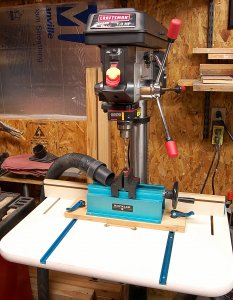NOW, hold your pen blank securely with a vise or a hand clamp, as long as your "walls" of the blank are parallel, you will get a straight hole.
This method HAS to work---geometry is not negotiable.
Well , lets see now . I have blanks that have parallel walls in a nicely curved fashion , blanks that have parallel walls in a twisted fashion , blanks that have two parallel walls and two that are not , blanks that have no parallel walls and blanks that are round and curved , all from the best of IAP suppliers , and some that are perfect in every way . None except the perfect will function well in a traditional vise setup , nor will the blanks I saw myself , on a poor old meat bandsaw , or , more frequently , the branches I use without any preparation .
In addition , seldom do I seem to think that the best possible appearing pen will come from drilling the blank down its mathematical center . Most of the time I want to drill at a cockeyed angle , as long as the blank has enough meat for the pen being made .
So , what to do ? The objective is to have the drill bit enter the blank where you want it to , and exit it where you want it to . To do that , the blank must be held in such a manner as to ensure that these two points are directly in line with the drill press stroke .
I take a 3/4 - 1 inch MDF or equivalent dead flat board , put a #8 or 10 screw about 1/4 inch through it , clamp it to the drill press table (2 clamps) so that the tip of the drill bit will come down to the tip of the screw , making sure that the table is clamped to the post , making sure to note the drill press depth setting when the points are together .
I then mark the desired entry and exit points on the blank , take a center punch and lightly tap these points to create a small conical dimple (EXCEPT if I am crazy enough to be using PR or other brittle plastics where it is wiser to use a small drill ).
My 12 inch vise grips then come out , take a reasonable grip on the blank , my hand takes a reasonable grip on the vise grips , the exit point gets put on the screw tip , the entry point gets thr drill bit point , and I drill .
Perfection ? NOPE . I can`t hold the blank absolutely steady , I don`t always get the entry point exactly right , uneven wood hardness , a wood/plastic boundary or angled wood grain may make the hole a bit oblong at the entry point
DON`T do this with your Eagle or other good segmented blank . It is a rough and ready technique that will work most of the time My failures are invariably with partly punky woods that I neglect to stabilize with thin CA .
Oh , Ed , I just happen to operate a free non-parallel blank disposal service
Wayne

